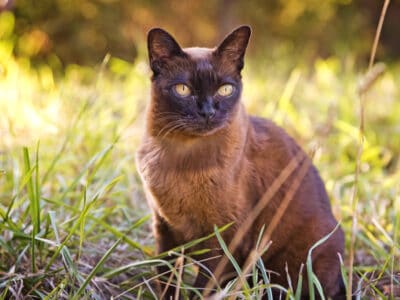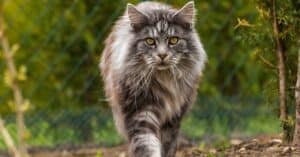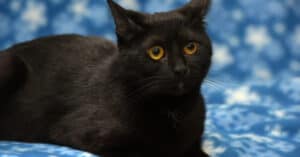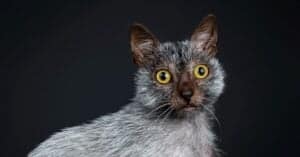Top 8 Heaviest / Fattest Cats
Cats were first domesticated as they learned to work as vermin killers in human settlements, but many cats have since grown lazy and complacent. Despite that, we continue to have an obsession with the heaviest and fattest cats around. They dominate our social media feeds and our Sunday comic strips, and the Guinness Book of World Records had to stop tracking the fattest cat in the world decades ago out of fear that owners would intentionally overfeed their pets for a shot at fame.
But the heaviest cats in the world become that way for a reason. Some breeds have habits that make them more prone to overeating or inactivity, while others have put on the pounds to become more effective predators in the wild. Whatever the reason the world’s heaviest cats are that way, they remain the same lovable companions they always are. Here are eight of the heaviest cats in the world.
#8: Savannah — Carrying the Weight of Its Wild Ancestors

iStock.com/ajr_images
The wild African cat known as the serval averages around 25 pounds in weight, and that’s roughly the maximum weight of the Savannah cat. Though a fully domesticated breed, most Savannahs have roughly 15% serval DNA in them. Older generations tend to be larger thanks to a greater amount of Serval DNA, so it’s possible that the Savannah won’t continue to rank among the world’s heaviest cats forever. But it would be disingenuous to call these cats fat. Savannah cats may be heavy, but their bodies are muscular and exceedingly long. The longest cat in the world is a Savannah. Arcturus Aldebaran Powers reached a towering height of 19 inches and weighed an impressive 30 pounds.
#7: Turkish Van — As Powerful as It is Heavy
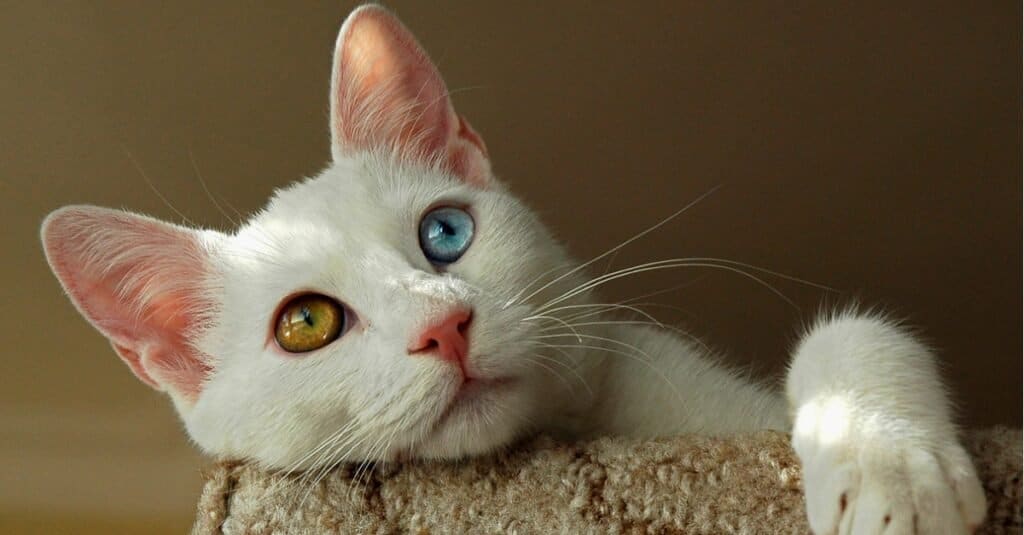
iStock.com/undefined undefined
An adult Turkish van can reach a weight of 15 pounds, but its beautiful and fluffy fur can conceal how large and powerful this breed of cat is. Their structure is stocky and muscular, and these cats are both powerful leapers and competent and comfortable swimmers. Turkish vans rarely stop moving — and while they’re loving cats who develop close bonds with their families, they have a lively and independent spirit as well. But putting on those pounds doesn’t happen overnight. The Turkish van takes between two to three years to reach its full adult size, but they maintain a kittenish clumsiness well into old age.
Far from delicate and known for their rowdy demeanors, they can get along well with dogs and are often even compared to puppies in terms of personality.
#6: Sphynx — Hairless and Prone to Pot Bellies

iStock.com/Jpr03
As the world’s most recognized bald cat breed, the Sphynx stands out in a lineup. And while these cats aren’t necessarily any more prone to overeating than other breeds, the sphynx’s unique physiology can sometimes make finding the right nutritional balance difficult. Because they have high metabolisms, active personalities, and no fur to insulate them from the cold, these cats typically need to devour a lot more food in the average day than other breeds. But since these cats have no hair and are naturally lean, they often look underweight even when they’re right in the sweet spot for nutritional balance.
As a result, many owners tend to overfeed their sphynx cats or not notice when their grazing gets out of control. A pale potbelly might look cute on your little guy, but it’s also a sign that they may be becoming unhealthy. The average sphynx weighs only six to 12 pounds, but one of its largest members on record — a British cat named Boo — reached a hefty 24 pounds.
#5: Persian — Pop Culture’s Most Famous Fat Cat Breed

iStock.com/adamdowdee282
It’s long been theorized that comic strip cat Garfield belongs to the Persian breed. But while cartoonist Jim Davis has never provided a definitive answer, the breed does tend to share both Garfield’s laziness and his propensity for overeating. Genetics has a big part to play in that. Their squat and stocky bodies aren’t particularly equipped for jumping or climbing, serious activity tends to mat and soil their fur, and their flat noses result in them becoming easily exerted.
This inactivity can help contribute to obesity, and many Persians who are allowed to graze will do so out of boredom. While some Persians may require a specialized diet to offset health issues, it generally requires little more than measuring out meals, limiting treats, and making sure they get regular play that’s not overly strenuous.
#4: Domestic Shorthair — A Breed Regularly Breaking Fat Cat Records
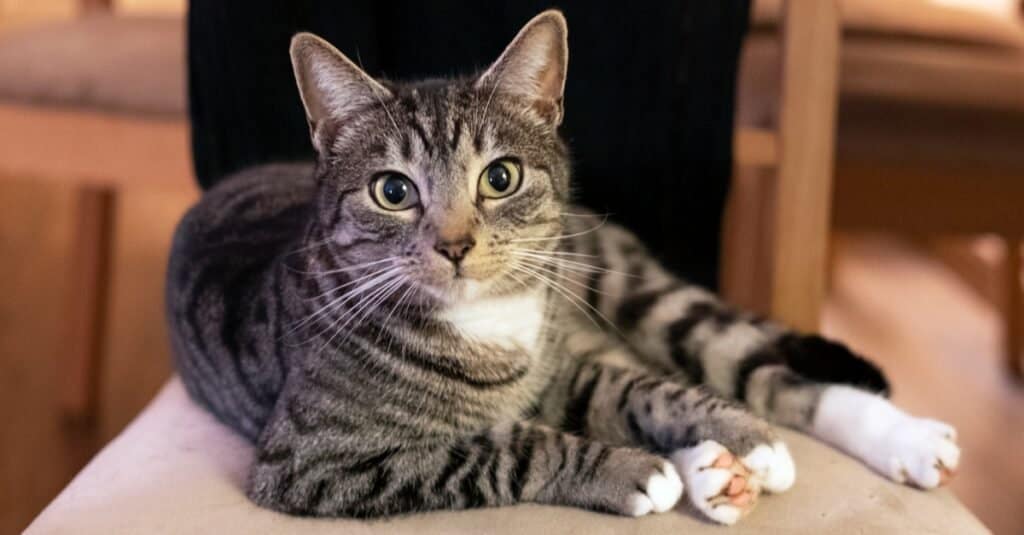
iStock.com/Ana Iacob
Domestic shorthairs aren’t a breed so much as they’re a catchall category for any cats that don’t belong to a specific breed — and it’s estimated that they represent a shocking 95% of the total house cat population. And while domestic shorthairs don’t have any particular predisposition towards obesity, their population domination ensures that they also tend to dominate the lists of fattest cat winners and contenders. An Australian domestic shorthair named Himmy held the position of the fattest cat in the world with a weigh-in of 46.8 pounds until he died in 1986. Since then, a domestic shorthair named Meow the cat has become the fattest cat living with a bodyweight of 39.7 pounds. Meow the cat earned celebrity fame and numerous guest spots on Anderson Cooper, but he, unfortunately, passed on in 2012 due to complications with his obesity.
#3: Ragamuffin — Naturally Large But Prone to Obesity

iStock.com/PaaschPhotography
The ragamuffin isn’t the largest domestic breed, but they’re significantly larger than the average house cat. Whereas the average house cat tops out at around 10 pounds, female ragamuffins can reach 15 pounds, and males can easily clear 20 pounds without running the risk of obesity. But the actual weight of a ragamuffin can be deceptive thanks to its naturally large size and their voluminous coats.
Like the similarly long-haired Persian, the ragamuffin has a reputation for being lazy, and they’ll typically be perfectly content living most of their lives as a lap cat. Factor in the fact that ragamuffins are also prone to eating, and it can be incredibly challenging to keep a stubborn member of this breed from gaining weight. Since obesity can be harder to identify in these gigantic cats, it’s prudent to work with your veterinarian to come up with a nutritional plan for your ragamuffin.
#2: Norwegian Forest Cat — Large and Highly Active
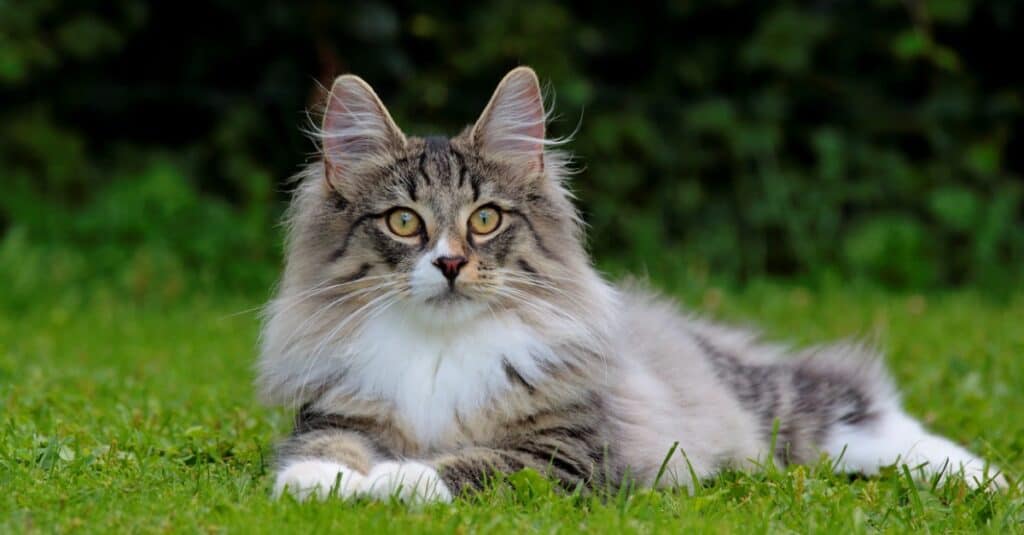
iStock.com/undefined undefined
The Norwegian Forest Cat — commonly and affectionately known as the “wegie” — is widely acknowledged as the second-largest cat breed around. Females can weigh between eight and 18 pounds, while males will typically average 12 to 20 pounds. But big doesn’t necessarily mean fat, as a large portion of a wegie’s weight can be attributed to their thick winter coat and their muscular frames. These are rugged cats rumored to have been brought to North America by early Viking explorers, and they require both a large amount of food and an active lifestyle to stay fit and healthy. As is the case with other large breeds, wegies are prone to unhealthy weight gain. This is especially true when dealing with Norwegian forest cats that are older, known to have existing health issues, or restricted to spaces too small for them to properly exercise.
#1: Maine Coon — The World’s Largest Domestic Breed
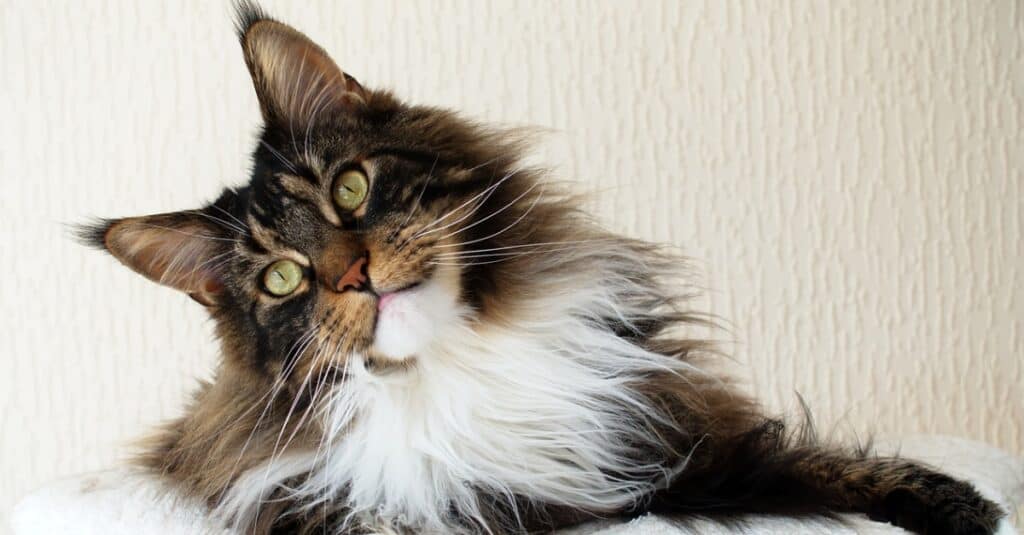
iStock.com/Bettina_Sentner
While house cats with the most absurdly record-setting weights tend to be traditional domestic shorthairs, the Maine Coon cat is recognized as the largest domestic breed on average — and that applies to both weight and length. Maine Coon cats hold the successive records or longest cat in the world. Nevada local Stewie measured 48.5 inches long, while his English successor Ludo measured 46.6 inches. They weighed 33 pounds and 34 pounds respectively. From appearances and size alone, it should come as little surprise that the Maine Coon cat shares some ancestry with the Norwegian Forest Cat.
According to our research, these are the heaviest and fattest cat breeds:
- Savannah
- Turkish Van
- Sphynx
- Persian
- Domestic Shorthair
- Ragamuffin
- Norwegian Forest Cat
- Maine Coon
Next Up: Top 10 Scariest Cats
More from A-Z Animals
Cats were first domesticated as they learned to work as vermin killers in human settlements, but many cats have since grown lazy and complacent. Despite that, we continue to have an obsession with the heaviest and fattest cats around. They dominate our social media feeds and our Sunday comic strips, and the Guinness Book of World Records had to stop tracking the fattest cat in the world decades ago out of fear that owners would intentionally overfeed their pets for a shot at fame.
But the heaviest cats in the world become that way for a reason. Some breeds have habits that make them more prone to overeating or inactivity, while others have put on the pounds to become more effective predators in the wild. Whatever the reason the world’s heaviest cats are that way, they remain the same lovable companions they always are. Here are eight of the heaviest cats in the world.
#8: Savannah — Carrying the Weight of Its Wild Ancestors

iStock.com/ajr_images
The wild African cat known as the serval averages around 25 pounds in weight, and that’s roughly the maximum weight of the Savannah cat. Though a fully domesticated breed, most Savannahs have roughly 15% serval DNA in them. Older generations tend to be larger thanks to a greater amount of Serval DNA, so it’s possible that the Savannah won’t continue to rank among the world’s heaviest cats forever. But it would be disingenuous to call these cats fat. Savannah cats may be heavy, but their bodies are muscular and exceedingly long. The longest cat in the world is a Savannah. Arcturus Aldebaran Powers reached a towering height of 19 inches and weighed an impressive 30 pounds.
#7: Turkish Van — As Powerful as It is Heavy

iStock.com/undefined undefined
An adult Turkish van can reach a weight of 15 pounds, but its beautiful and fluffy fur can conceal how large and powerful this breed of cat is. Their structure is stocky and muscular, and these cats are both powerful leapers and competent and comfortable swimmers. Turkish vans rarely stop moving — and while they’re loving cats who develop close bonds with their families, they have a lively and independent spirit as well. But putting on those pounds doesn’t happen overnight. The Turkish van takes between two to three years to reach its full adult size, but they maintain a kittenish clumsiness well into old age.
Far from delicate and known for their rowdy demeanors, they can get along well with dogs and are often even compared to puppies in terms of personality.
#6: Sphynx — Hairless and Prone to Pot Bellies

iStock.com/Jpr03
As the world’s most recognized bald cat breed, the Sphynx stands out in a lineup. And while these cats aren’t necessarily any more prone to overeating than other breeds, the sphynx’s unique physiology can sometimes make finding the right nutritional balance difficult. Because they have high metabolisms, active personalities, and no fur to insulate them from the cold, these cats typically need to devour a lot more food in the average day than other breeds. But since these cats have no hair and are naturally lean, they often look underweight even when they’re right in the sweet spot for nutritional balance.
As a result, many owners tend to overfeed their sphynx cats or not notice when their grazing gets out of control. A pale potbelly might look cute on your little guy, but it’s also a sign that they may be becoming unhealthy. The average sphynx weighs only six to 12 pounds, but one of its largest members on record — a British cat named Boo — reached a hefty 24 pounds.
#5: Persian — Pop Culture’s Most Famous Fat Cat Breed

iStock.com/adamdowdee282
It’s long been theorized that comic strip cat Garfield belongs to the Persian breed. But while cartoonist Jim Davis has never provided a definitive answer, the breed does tend to share both Garfield’s laziness and his propensity for overeating. Genetics has a big part to play in that. Their squat and stocky bodies aren’t particularly equipped for jumping or climbing, serious activity tends to mat and soil their fur, and their flat noses result in them becoming easily exerted.
This inactivity can help contribute to obesity, and many Persians who are allowed to graze will do so out of boredom. While some Persians may require a specialized diet to offset health issues, it generally requires little more than measuring out meals, limiting treats, and making sure they get regular play that’s not overly strenuous.
#4: Domestic Shorthair — A Breed Regularly Breaking Fat Cat Records

iStock.com/Ana Iacob
Domestic shorthairs aren’t a breed so much as they’re a catchall category for any cats that don’t belong to a specific breed — and it’s estimated that they represent a shocking 95% of the total house cat population. And while domestic shorthairs don’t have any particular predisposition towards obesity, their population domination ensures that they also tend to dominate the lists of fattest cat winners and contenders. An Australian domestic shorthair named Himmy held the position of the fattest cat in the world with a weigh-in of 46.8 pounds until he died in 1986. Since then, a domestic shorthair named Meow the cat has become the fattest cat living with a bodyweight of 39.7 pounds. Meow the cat earned celebrity fame and numerous guest spots on Anderson Cooper, but he, unfortunately, passed on in 2012 due to complications with his obesity.
#3: Ragamuffin — Naturally Large But Prone to Obesity

iStock.com/PaaschPhotography
The ragamuffin isn’t the largest domestic breed, but they’re significantly larger than the average house cat. Whereas the average house cat tops out at around 10 pounds, female ragamuffins can reach 15 pounds, and males can easily clear 20 pounds without running the risk of obesity. But the actual weight of a ragamuffin can be deceptive thanks to its naturally large size and their voluminous coats.
Like the similarly long-haired Persian, the ragamuffin has a reputation for being lazy, and they’ll typically be perfectly content living most of their lives as a lap cat. Factor in the fact that ragamuffins are also prone to eating, and it can be incredibly challenging to keep a stubborn member of this breed from gaining weight. Since obesity can be harder to identify in these gigantic cats, it’s prudent to work with your veterinarian to come up with a nutritional plan for your ragamuffin.
#2: Norwegian Forest Cat — Large and Highly Active

iStock.com/undefined undefined
The Norwegian Forest Cat — commonly and affectionately known as the “wegie” — is widely acknowledged as the second-largest cat breed around. Females can weigh between eight and 18 pounds, while males will typically average 12 to 20 pounds. But big doesn’t necessarily mean fat, as a large portion of a wegie’s weight can be attributed to their thick winter coat and their muscular frames. These are rugged cats rumored to have been brought to North America by early Viking explorers, and they require both a large amount of food and an active lifestyle to stay fit and healthy. As is the case with other large breeds, wegies are prone to unhealthy weight gain. This is especially true when dealing with Norwegian forest cats that are older, known to have existing health issues, or restricted to spaces too small for them to properly exercise.
#1: Maine Coon — The World’s Largest Domestic Breed

iStock.com/Bettina_Sentner
While house cats with the most absurdly record-setting weights tend to be traditional domestic shorthairs, the Maine Coon cat is recognized as the largest domestic breed on average — and that applies to both weight and length. Maine Coon cats hold the successive records or longest cat in the world. Nevada local Stewie measured 48.5 inches long, while his English successor Ludo measured 46.6 inches. They weighed 33 pounds and 34 pounds respectively. From appearances and size alone, it should come as little surprise that the Maine Coon cat shares some ancestry with the Norwegian Forest Cat.
According to our research, these are the heaviest and fattest cat breeds:
- Savannah
- Turkish Van
- Sphynx
- Persian
- Domestic Shorthair
- Ragamuffin
- Norwegian Forest Cat
- Maine Coon
Next Up: Top 10 Scariest Cats


